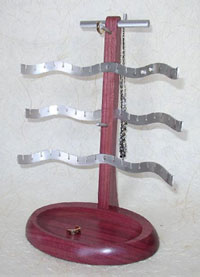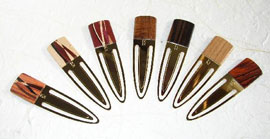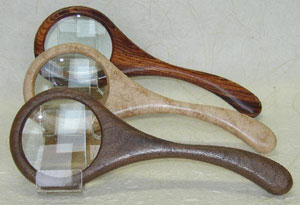
There seem to be two schools of business for making a living from woodworking. In one school are the cabinetmakers or carvers with ready access to wealthy patrons willing to spend hundreds or thousands on pieces that may take months to complete. In the other school are craftsmen who’ve adopted a production model that meets both the demands of a wholesale market and their own creative needs. The company of Davin and Kesler is a master in the latter school.
Working in a nineteenth century mill overlooking Dorset Mill Pond in the Rhode Island countryside, Tom Davin and Mary Kesler — husband and wife partners — have spent almost three decades carving out a profitable niche, primarily in the wholesale crafts market.
Back in the mid 1970s — and with no previous experience — Tom studied cabinetmaking in the industrial design department at California State University in Northridge. Upon graduation he launched his woodworking business. When Mary got accepted at UC Davis, the couple moved to the farm belt town of Woodland, near Sacramento, California. Mary got “dragged into the business,” as Tom put it, because he needed help and couldn’t afford to hire anyone. While pursuing her degree in nutrition, Mary also took woodworking classes to augment her involvement in the business.
Tom had previously done some large pieces of furniture, but after the move, he began to reevaluate his business.

“I think the simplicity of a lot of Asian designs is beautiful and elegant.” Tom noted, “The same is true of a lot of different designs, but our breadboard always seems to ring true for me. Its simplicity is really nice to live with.”
“There really wasn’t an easy market like there was in the Los Angeles area for the bigger pieces. I started looking around at stores and saying that I could do this kind of work – like jewelry boxes & and even compete on the price. We started doing a lot of craft shows in the Bay area, did a couple of wholesale shows in LA, and the American Craft Council in San Francisco where the first few days of the show are wholesale. We had gallery owners and high-end department stores such as Nieman Marcus coming in and looking, and we realized there was this whole other world of small crafts.”
The couple decided on a mix of 75-80% wholesale and 20% retail & a proportion they’ve stuck to ever since. And as their business grew and they contemplated raising a family, they decided it was time for another move.
“We got to a point where half of our business was on the West Coast and half on the East Coast.” Tom noted, “We drove around [New England] and really liked it. We decided the quality of life we’d have on the East Coast was a pretty good bang for the buck. It was a good move!”
The couple found and rented space in an old textile mill. And around 1984, they bought the entire building. The business made money from the start, “because there was no alternative,” Tom recalled.
Over the years, original designs have evolved and new ones emerged. Tom explained the design process as knowing what you do well and then finding products that utilize that expertise.

“Most designs start with conversation. We ask what people liked and wanted and how we could make it better. Some of our best products have come from storeowners. They never suggest design or shape but say they really need letter openers, chopsticks, a sushi board, etc. and then we go back and try to create them. We go through the sketch process, and at some point I need to do some mock-ups, which could be real down and dirty with the band saw and glue gun. The hard part is to come up with a design that you can make efficiently and that still looks and feels right. It has to look like something you can’t do at home and or even want to try. You might come up with a beautiful design, but if it’s going to retail for $250, you’re only going to sell three of them.”
And some products just don’t work out over time.
“We did jewelry boxes for years, big boxes, boxes with doors, pullouts and drawers. After 15-18 years of doing boxes we finally just gave up. It didn’t really matter how you did it; customers came in and told us the box was really nice, but then they’d ask if we had one with a drawer that just holds earrings. It always needed to be a little different and I thought, you know, I don’t really enjoy this.”
In recent years some of the couple’s best-sellers have been letter openers and earring and necklace holders. Their chopsticks of ebony and bird’s-eye maple have also sold well. What amazes Tom is that they’ve been doing a very similar design all along and no one has copied it yet. But in spite of their success, Tom wouldn’t advise anyone to get into the business today. The emergence of higher quality imports is one of the biggest factors.
Their shop is about ten miles from home. And today, even with three employees, Tom is in the shop about 40 hours a week. The workspace has grown to 6,000 square feet. Two separate milling setups each include a joiner, planer, table saw, and band saw. The shop also includes a metal cutting band saw for cutting brass and aluminum.
There have been other changes over the years. They have three children. Mary used to be very hands onhands-on with production, but now handles everything outside of the shop. Tom admits he was horrible with the office end of things, and Mary getting them better organized has meant a better bottom line for the business.

But they still attend some craft shows & with retail still accounting for 20% of the business. Mary was headed to St. Paul, Minnesota, the day after our conversation to attend the American Craft Council Show, one of their favorites. And after all these years they still love the business and the craft.
“We come up with the idea, design, production, and all of the marketing.” Tom noted, “That’s what I like about it; it’s still so small and simple. If things work, we can take credit for it, and if it doesn’t work, we have to look at it and figure out if it is something we did or a decision we made that caused it to fail. I think that is the beauty of it.”
You can see more of Davin and Kesler at their web site.





